The Bogota bus system: demystifying the TransMilenio
Updated July 2019. In a city where getting from A to B can be stressful, tiring and chaotic, it doesn’t help that the SITP and TransMilenio system (i.e. the Bogota bus system is extremely hard to fathom, even for some Bogotanos!
Look at a Bogota bus network map at any station and it might as well be written in ancient Greek for all the sense it makes – don’t expect to be able to look at it to find out which number buses you need to take, or where to change!
So here’s a short guide on how to use the TransMilenio!
There are two ways to find out which buses you need.
Ask someone for help at the station
Look for an ‘Auxiliario‘ in a green, military-looking uniform for help, by telling them your destination. They won’t speak English, so try to listen out for the letter and the number in Spanish (B23 for example). Alternatively, ask them to write it down or type it into your phone.
Download the Transmilenio and SITP app.
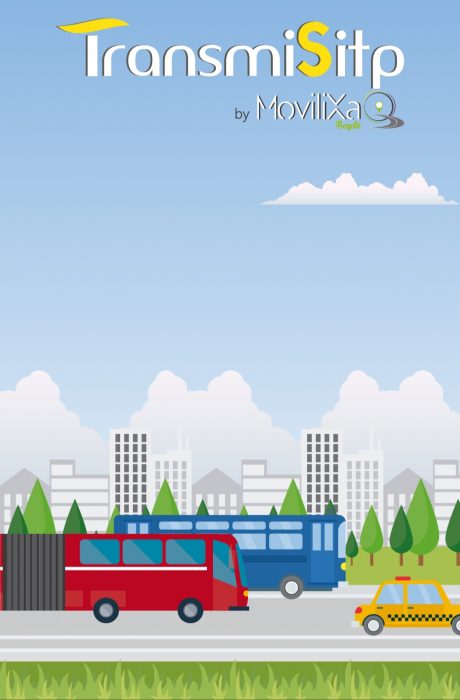
Use this to help you use the TransMilenio or SITP buses, which are both part of the Bogota bus system. Go to the Apple Store or Google Play Store and search for “Transmilenio” to bring up the app and install it.
Now, there are different ways of working out which bus you need to take. The app is not the most intuitive to use, so I’m going to outline the way that I think is easiest.
Find out which bus stations you need to use
Unfortunately, the app does not always make it as simple as selecting “Your location” and a place like “Parque de la 93” or “Centro Andino”. If you select those options, the app will tell you that “No routes were found.” So ask your hotel receptionist or your Airbnb owner or a friend which station is nearest to where you are now. Then ask whoever you’re meeting (or the same person as before) which bus station is nearest to where you need to go.
Example
If you are staying in the Candelaria, your best TransMilenio options will be Museo del Oro or Las Aguas stations. If you want to go to Andino shopping mall in Bogota’s Zona T, you will need to take a TransMilenio bus to Héroes station. Let’s say you’re going to take the bus from Museo del Oro.
How to calculate your TransMilenio route
Open the app and tap on ‘Please your trip in Transmi or SITP’.
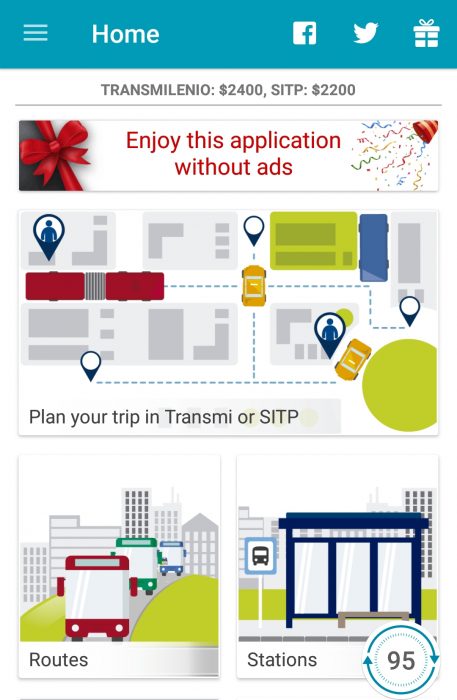
You then enter the name of the station your starting at (where it says “Your location” and the name of the station you want to go to (“End”). It will then give you a list of possible routes. So in our example, we would enter “Museo del Oro” where it says “Your location” and “Héroes” where it says “End”. Alternatively, you can tap on Mapa del Sistema and tap the start and end stations on the map, if you know the system quite well already.
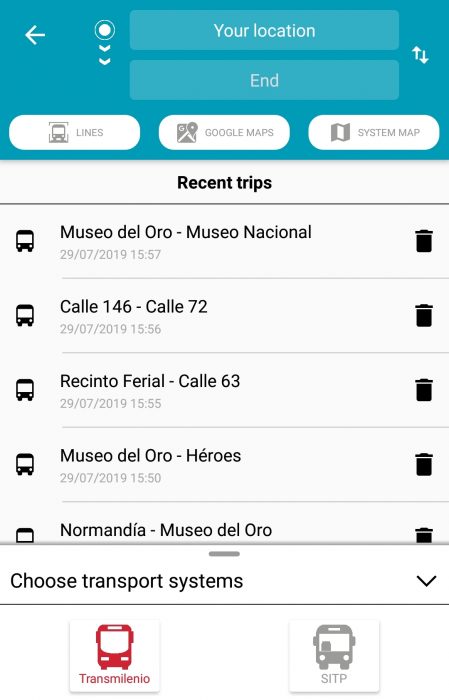
It will then show you your start and end points on the map. To confirm, tap the orange button in the bottom right corner.
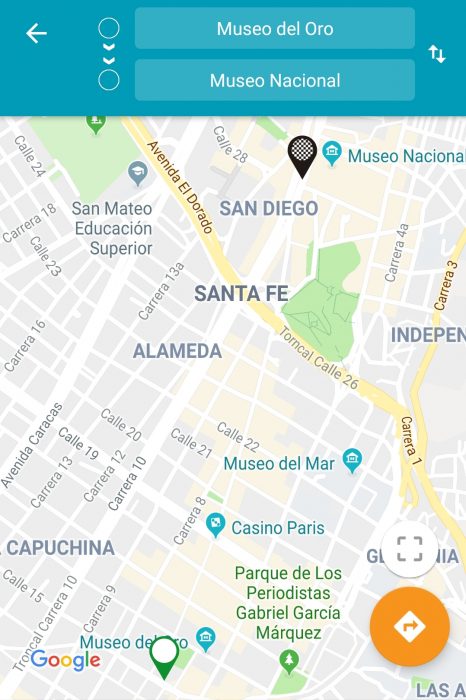
The app will tell you which bus(es) you have to take, which station to change at (if necessary) and how long each leg of the journey will take. Here’s an example, if I wanted to travel from Museo del Oro to Heroes:
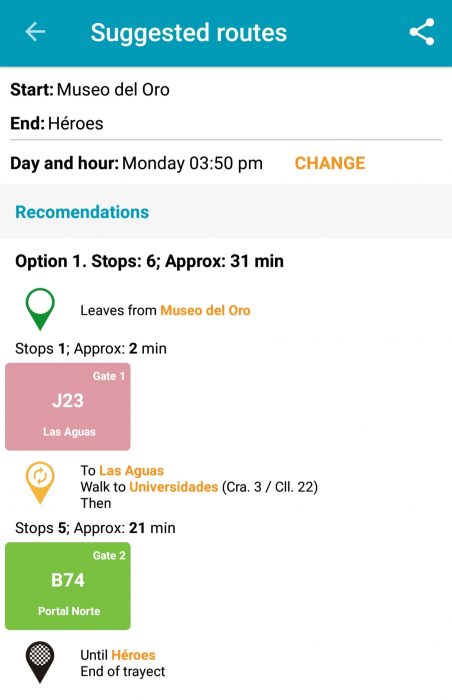
In this case, you would need to take a bus to ‘Las Aguas’ (which is also walkable from Museo del Oro) and then change, taking a bus from Universidades (down the connecting tunnel inside the station) to Heroes.
Where to take your bus from at the station
Unless your taking a TransMilenio bus down Carrera 7 (in which case you’ll take it from the side of the road) you’ll be at a station that has a very long platform with many different door. Each door has bus numbers above it, so you can either walk along the platform and look for your bus number, or ask an Auxiliario (a station worker) by just saying the bus number in Spanish, or by writing it down, and they will point you in the right direction. You may end up having to walk the entire length of the platform to find the bus you need.
Station conditions: be ruthless
Annoyingly, several buses stop at the same place on each platform, so that people waiting for different buses are waiting at the same doors. This means that if you are at the back of the crowd of people waiting by a particular set of doors, you may be only one of few waiting for that bus. In this case, you need to ruthlessly shove your way through the crowd to get on the bus. If you don’t, you may find that when the bus stops, nobody moves because it’s not their bus, and you are left at the back. By the time you’ve politely squeezed your way to the front, the bus has already gone (this has happened to me more than once). Moral of the story – BE RUTHLESS.
Bogota bus etiquette?
In a word: no. There is no etiquette when it comes to embarking and disembarking the TransMilenio buses. People will push their way onto the bus while people are still trying to get off and often this results in a gridlock. It can feel quite dangerous sometimes, but just try to keep your footing and hold onto your shoes. I once lost one in the gap between the bus and the platform.
The red seats or the blue seats?
On the TransMilenio, you will see mainly red seats and some blue seats. The blue seats are reserved for pregnant women, old people, and people with young children. You can sit in them if no-one else is sitting there or in need of it. However, you will be expected to get up as soon as someone gets on the bus who does need it. This includes women who look aged 50+.
How much do Bogota bus tickets cost?
In 2019, a one-way ticket (including changes) costs $2,300 pesos. There are ticket offices at every station. If you don’t already have one, you will need to buy a green plastic rechargeable TuLlave TransMilenio card, which costs $5,000 pesos (2019). If you don’t present one when requesting a ticket, they will sell you one there and then. Just say “uno” for one journey or hand over the amount of money you want to put on the card (and check your change, if necessary). When you get to the barrier, touch the card to the reader until it beeps and then go through the turnstile once the light turns green.
Beggars and sellers on the TransMilenio buses
At each TransMilenio stop, beggars and sellers will board the buses. Beggars are often quite normal-looking people and aren’t a reason to be intimidated. Nowadays, a large proportion are Venezuelans trying to earn a living and survive. They will introduce themselves, and either tell you their story and explain why they’re asking for money, or they will just say what they’re selling (usually packets of potato chips/crisps, sweets, biscuits, chocolate bars etc.). It is fine to say “No gracias” when they approach you, unless you want to buy what they’re offering. Be aware that on a single bus journey you may encounter as many as 3 or 4 different people who get on at each stop either selling or begging. It’s ok to politely say no – otherwise you could end up spending several times your bus fare on one journey.
Safety tips
Avoid flashing your cellphone in the TransMilenio bus station and keep your wallet in your bag or in a zipped-up pocket out of sight. If you have a backpack, wear it ‘kangaroo-style’ around your front, not on your back. It’s also a good idea not to take out your wallet on the bus, as robberies do happen. If you think you might want to buy a snack from a seller on the bus, keep some loose change in your pocket.
Transmilenio buses on the Carrera 7
As I mentioned before, there are TransMilenio buses that go up and down Cra. 7 but they don’t have stations. They just stop at bus stops on the side of the road. As buses are being added to this route all the time, some bus-stops have not yet been updated with the new bus numbers.
There aren’t machines near bus-stops to top-up TuLlave cards. You either need to find a shop with a ‘Tu Llave’ sign in the window, or you need to go to one of the TransMilenio stations with a ticket office, for example on Avenida Caracas/Autopista or Calle 26.
Another option if you don’t have credit on your card is to ask someone on the bus if they’ll sell you a ticket and let you use their card. Just adopt a mournful look and say “Alguien puede venderme un pasaje?” Usually works!
If you have a green ‘Tu Llave’ TransMilenio card, and you have a balance of between $0 and $2,000 pesos (i.e. not quite enough for one journey) these buses will let you go into minus credit for just one journey.
Alternatives to the Bogota bus system
Just order a taxi or an Uber-type car service. It’s often not that expensive and it’s so much easier!
Tell us about your experience using Bogota’s TransMilenio system in the comments section below!
If you have found this blog informative or entertaining and would like to support How to Bogotá, you can now buy me a digital cup of coffee!
This blog is a labor of love – I don’t make any money from it and I don’t want to start monetising it through advertising (cos that’s just annoying!). So this is the best way I’ve found to offer readers the chance to support How to Bogotá (other than giving me your loyal readership, for which I’m very grateful!)
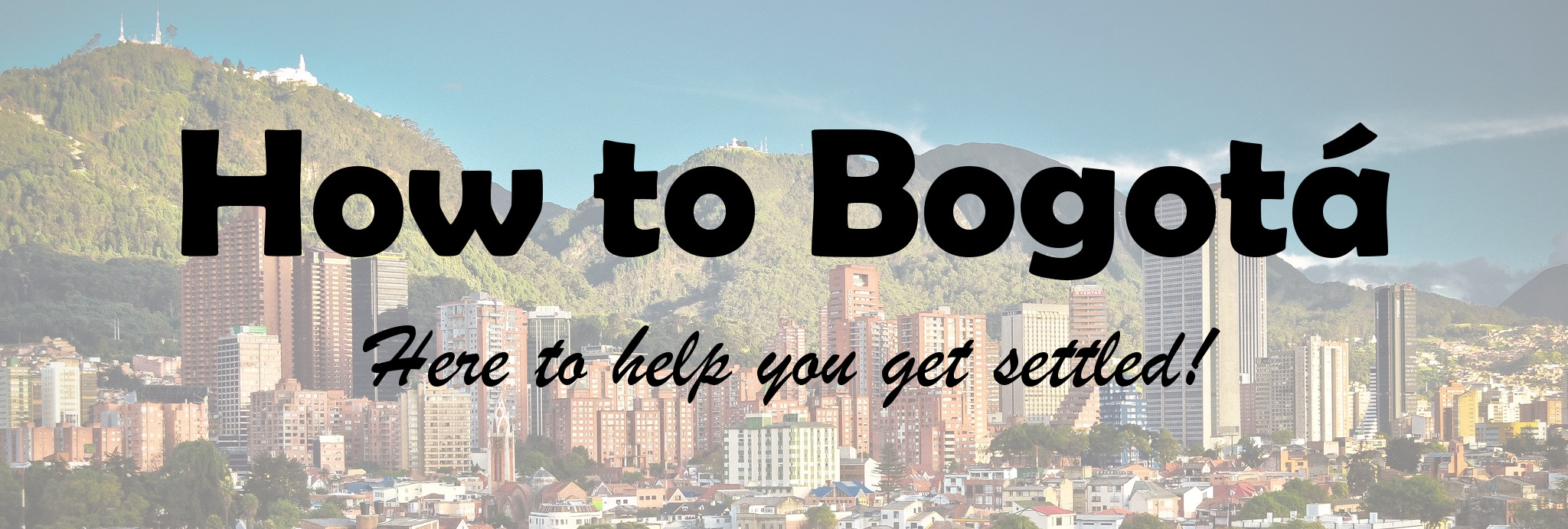
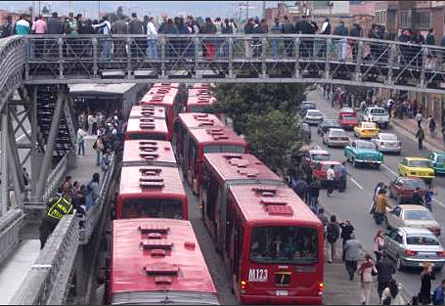






I’ve had success using the Moovit phone app, which is used similarly to the official bus system app. Moovit also worked well for me in Santa Marta. I enjoyed using the Transmilenio; the main thing that took a while to learn is that (as you said) not all buses along a route stop at every station.
Thanks Eric! I find the Transmilenio app less helpful nowadays since it’s been updated. I must try Moovit!